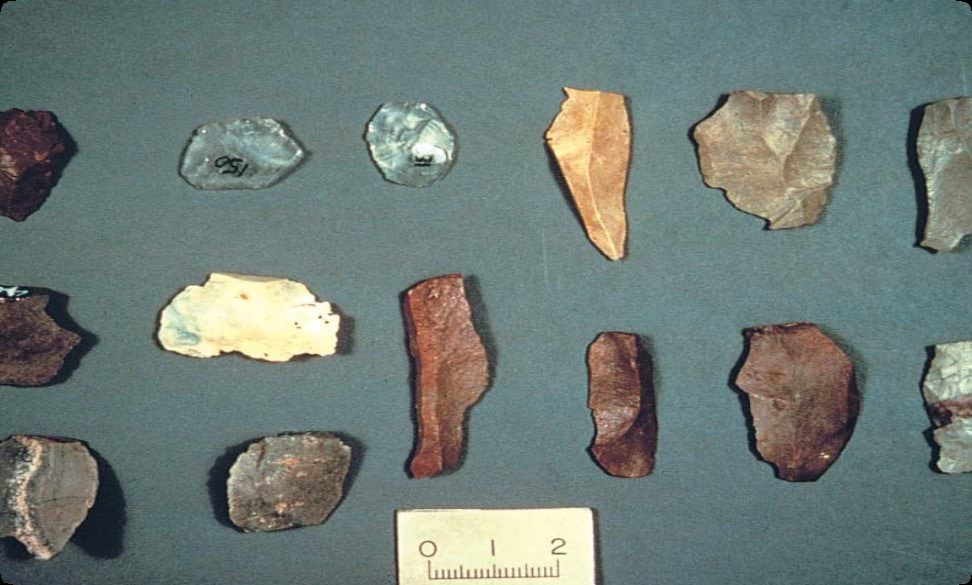Characteristics
General
- sharp edges
- retouch along one or more edges
- stone rich in silica
- stone type often different to the natural rock in the area
Flakes
- usually less than 50 mm long
- a ‘striking platform’ (see diagram) visible
- impact point often present on the striking platform
- a ‘bulb of percussion’ often present below the striking platform
- may have been shaped into a recognisable tool form, such as a point or scraper
Cores
- may be fist-sized or smaller
- may have one or more scars where flakes have been removed
Not all of these features can be seen on each stone tool and some require an experienced eye to identify them. Breakage can remove some key features.
What are Aboriginal flaked stone tools?
Flaked stone tools were made by hitting a piece of stone, called a core, with a ‘hammerstone’, often a pebble. This would remove a sharp fragment of stone called a flake.
Both cores and flakes could be used as stone tools. New flakes were very sharp, but quickly became blunt during use and had to be sharpened again by further flaking, a process called ‘retouch’. A tool that was retouched has a row of small flake scars along one or more edges.
Retouch was also used to shape a tool. Not all types of stone could be used for making tools. The best types of stone are rich in silica, hard and brittle.
These include quartzite, chert, flint, silcrete and quartz. Aboriginal people quarried such stone from outcrops of bedrock, or collected it as pebbles from stream beds and beaches. Many flaked stone artefacts found on Aboriginal places are made from stone types that do not occur naturally in the area. This means they must have been carried long distances.

Where are flaked stone tools found?
Stone tools are the most common evidence of past Aboriginal activities in Australia. They occur in many places and are often found with other remains from Aboriginal occupation, such as shell middens and cooking hearths.
They are most common near rivers and creeks. It is easier to find them where there is not much vegetation or where the ground surface has been disturbed, for example by erosion.
What were flaked stone tools used for?
Flaked stone tools could be made quickly, and were used for many everyday tasks, including shaping objects made of wood, bark and bone.
They were used as spear-tips in hunting weapons and as knives to butcher game.
They were also used to scrape and prepare animal skins for making cloaks, containers and decorative items.
How else can stone be flaked?
Many natural processes can break stone. These include rockfall and extreme changes in temperature. Modern machines, such as ploughs, can also fracture stone. It is important to be able to distinguish stone that has been naturally or accidentally fractured from stone that was deliberately flaked by Aboriginal people.
Some of the characteristics of Aboriginal flaked stone artefacts may occasionally occur on naturally fractured stone. However, it is very rare for two or more of these characteristics to occur on the same piece of stone as the result of a natural process.
Why are flaked stone tools important?
Because stone artefacts do not rot or rust, they are often the only evidence of Aboriginal occupation in a particular area. Stone artefacts can provide information about where Aboriginal people lived, how they made other tools, hunted and prepared food. Sometimes traces of wood, plant food, or animal blood can survive on the edges of flaked stone tools.
Specific marks and damage on a tool from use can help tell us what it was used for. This is because different tasks, such as wood carving or scraping animal skins, damaged the edge in different ways. By finding the original source of stone that was used to make tools, it is sometimes possible to trace the movement of stone within an area. This tells us about Aboriginal systems of trade, exchange and social alliances.
There were a number of changes to the stone tools used by Aboriginal people over time. Because of this, stone tools can help provide an approximate age for the Aboriginal occupation of an area. Flaked stone tools are one of a range of artefacts that provide Aboriginal people today with an important link to their culture and past.
Threats to Aboriginal stone tools
Because stone artefacts are found in many different places, and are usually small, they can be difficult to protect. They are sometimes collected by people who do not understand the importance of leaving Aboriginal cultural materials where they are found. Erosion and weathering and activities such as ditch digging and ploughing can disturb flaked stone artefacts. They can also be broken when trampled by animals such as cows, or when run over by vehicles.
First Peoples - State Relations records flaked stone artefacts so that we will have a permanent photographic and written record of this important part of the heritage of all Australians. Some particularly good examples of places containing flaked stone artefacts may require active conservation so that they can be preserved for future generations.
Are flaked stone artefacts protected?
All Aboriginal cultural places in Victoria are protected by law. Aboriginal artefacts are also protected.
It is against the law to disturb or destroy an Aboriginal place. Artefacts should not be removed from site.
Please help to preserve Aboriginal cultural places by reporting their presence to First Peoples - State Relations.
What to do if you find a flaked stone tool
- do not remove any material from the area
- if you pick up a stone to examine it, make sure that you put it back where it came from
- check whether it has some of the key characteristics
- record the location, noting roughly how many stones there are
- note whether the area is under threat of disturbance.
Updated

